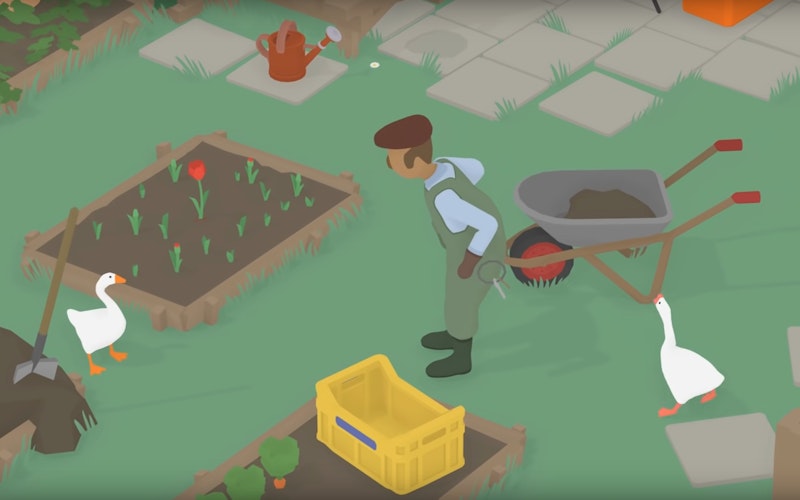
Games
Untitled Goose Game’s Theology of Play
Rest is just as important as work—even God rested after creation, and made rest holy. So is play, which is mentioned in the Bible again and again as God’s intended purpose for creation. Play is not merely an escape from work; it is a valuable blessing, an opportunity to share in creation, either by being creative or by taking joy in someone else’s work.
Untitled Goose Game is an excellent illustration of this idea, because it is a video game about play. The point is not to build anything or to fight monsters or even to grow as a character. There are no levels to achieve or points to earn. The point of Untitled Goose Game is to explore and wreak havoc in an otherwise sleepy English village, all while playing as an unruly goose. The effect mirror’s Philip Hefner’s ideas about co-creation: while playing the game, I am a free actor within the game’s world, able to play, to explore, and even to shape events within that world, all as an agent of the game’s creator’s intentions.
Technically, Untitled Goose Game is a puzzle game. Players have a list of goals they must accomplish in order to move on to new locations within the village, where they will have new opportunities for mischief. But none of these goals must be done in any particular order, and each of them is simple: throw a rake into a pond; get one of the villagers to put on a different pair of glasses; collect a number of items without anyone else noticing.
It’s possible to speed through the list of things to do, but it’s more fun to throw the list aside, sneak up behind different villagers going about their business, and honk loudly and watch their reactions. The game is designed to be fun and not just a list of chores to do. It’s a leisurely game and a good reminder that creation was not intended to just be work. Indeed, play is a holy blessing.
Play is not merely an escape from work; it's an opportunity to share in creation.
Playing as a goose has its limitations, of course. Players can only waddle around, pick things up in their beak, flap their wings, or honk. The villagers themselves grow wise to the antics of a wild goose running and honking around their village, which means that players must get creative in achieving their goals. Geese are inherently a little silly, with their long, snaky necks and their boat-shaped bodies, which are so unwieldy on land. Their feet slap a little when they walk, like clown shoes. This goose is no exception, waggling and honking as it runs around the village, and the effect is one of amusement. The game encourages this sense of play by keeping the to-do list simple: items are statements like “rake in the lake,” leaving players enough room to figure out the list’s requirements without demanding they complete them with any sense of urgency.
The game’s simplicity meshes well with its aesthetics. The goose and the village are represented in flat matte blocks of bright color, with no shading or unnecessary details. The goose itself is a splash of white, with a little yellowy orange for its beak and feet, and a small dot to represent one beady eye. Its body waggles as it waddles. The world of the game is a world that has been simplified down to its most basic parts. The effect is a little idyllic, but it also encourages the player to poke around the environment without getting distracted or stuck. It’s also genuinely beautiful.
A two-player version of the game was released in late September. Nothing else about the game has been changed; it’s just possible to play through the same village toward the same goals with two geese instead of one. The result is additional chaos and additional creativity: it’s possible for one player to achieve all of the goals on the list while another player runs interference, distracting villagers. It’s also possible—and fun—for both players to just run around the village honking at everyone and everything, with nothing actually getting done. Whether played with one player or two, the game encourages inefficient play. It’s a small game designed to be savored and enjoyed, not conquered.
When played as a two-player game, players share in this delight with each other; when played as a one-player game, it’s a small moment of connection with the developer who programmed the game, who coded its rules, and who anticipated that I might want to flip over a trash can just for fun. This small village was built specifically for the players’ enjoyment and play—a welcome respite, and the chance to view the world in a new and surprising way. I’ve been enjoying it as a means to take a break, to explore a small world outside the walls of my own small apartment. But in so doing, I’ve also been reminded of my own place in a larger creation—one in which I can be a free agent of unruly joy and play.
Topics: Games